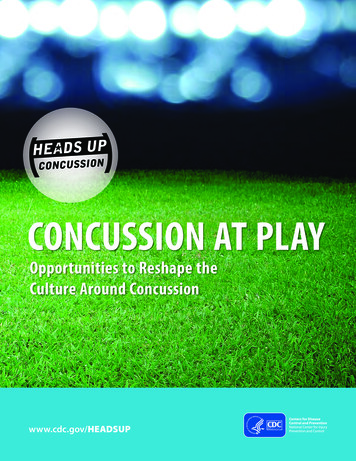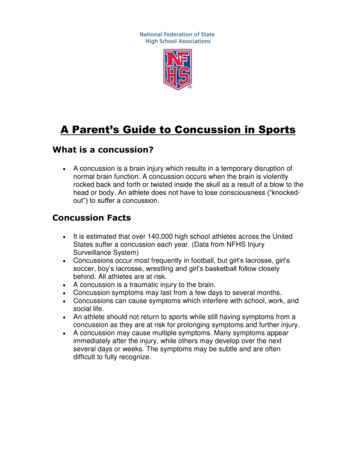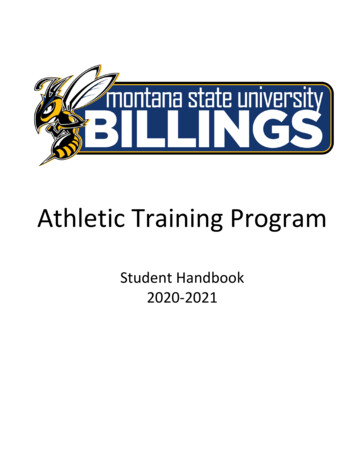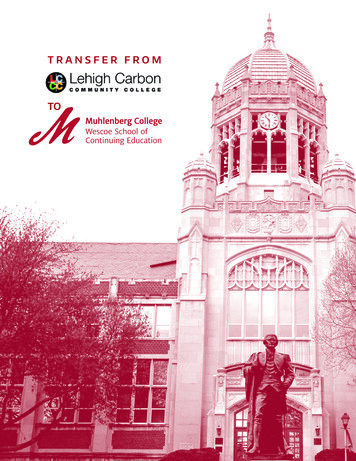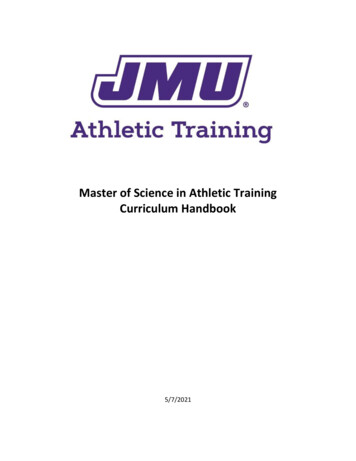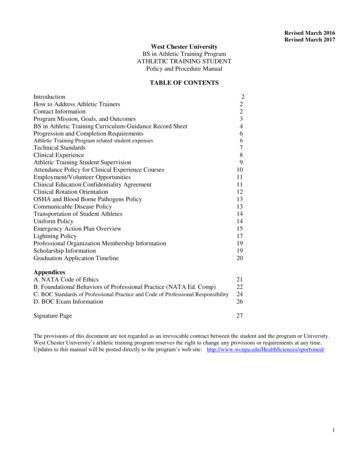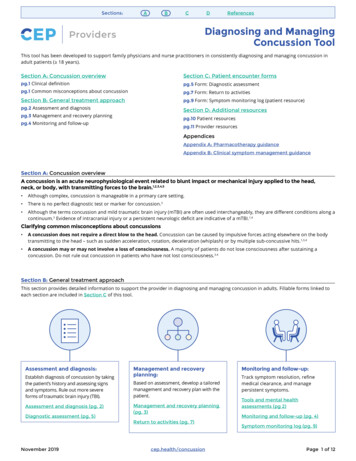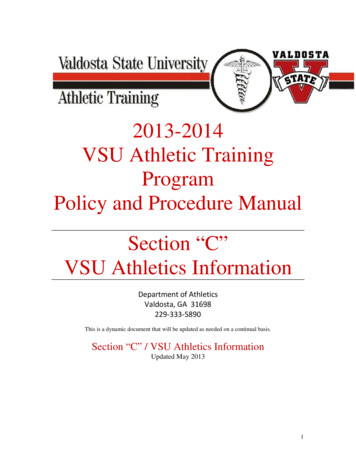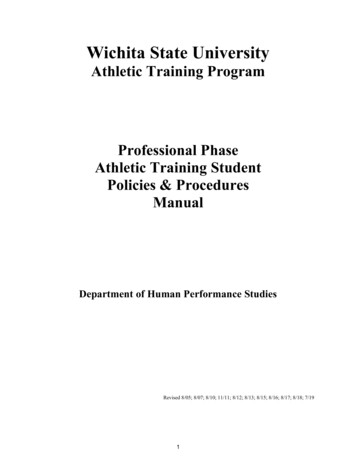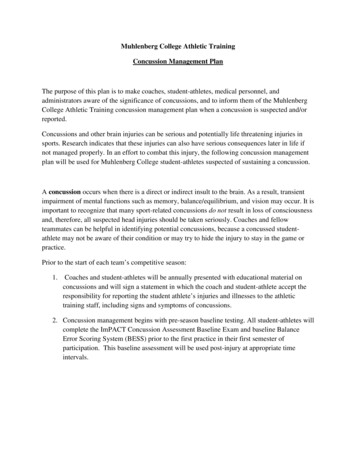
Transcription
Muhlenberg College Athletic TrainingConcussion Management PlanThe purpose of this plan is to make coaches, student-athletes, medical personnel, andadministrators aware of the significance of concussions, and to inform them of the MuhlenbergCollege Athletic Training concussion management plan when a concussion is suspected and/orreported.Concussions and other brain injuries can be serious and potentially life threatening injuries insports. Research indicates that these injuries can also have serious consequences later in life ifnot managed properly. In an effort to combat this injury, the following concussion managementplan will be used for Muhlenberg College student-athletes suspected of sustaining a concussion.A concussion occurs when there is a direct or indirect insult to the brain. As a result, transientimpairment of mental functions such as memory, balance/equilibrium, and vision may occur. It isimportant to recognize that many sport-related concussions do not result in loss of consciousnessand, therefore, all suspected head injuries should be taken seriously. Coaches and fellowteammates can be helpful in identifying potential concussions, because a concussed studentathlete may not be aware of their condition or may try to hide the injury to stay in the game orpractice.Prior to the start of each team’s competitive season:1.Coaches and student-athletes will be annually presented with educational material onconcussions and will sign a statement in which the coach and student-athlete accept theresponsibility for reporting the student athlete’s injuries and illnesses to the athletictraining staff, including signs and symptoms of concussions.2. Concussion management begins with pre-season baseline testing. All student-athletes willcomplete the ImPACT Concussion Assessment Baseline Exam and baseline BalanceError Scoring System (BESS) prior to the first practice in their first semester ofparticipation. This baseline assessment will be used post-injury at appropriate timeintervals.
Concussion Assessment1. Upon suspicion of a concussion, the student-athlete will be removed from practice orcompetition and evaluated by medical personnel with training in the diagnosis, treatment,and management of concussion. The initial evaluation will include: Symptom assessment.Physical and neurological exam.Cognitive assessment.Balance exam.Clinical assessment for cervical spine trauma, skull fracture and intracranialbleeding.2. No athlete is permitted to return to play the same day following a diagnosedconcussion.3. Any student-athlete will be immediately referred for emergency care via the venuespecific Emergency Action Plan if he/she presents with any of the following: Glasgow Coma Scale 13.Prolonged loss of consciousness.Focal neurological deficit suggesting intracranial trauma.Repetitive emesis.Persistently diminishing/worsening mental status or other neurologicalsigns/symptoms.Spine injury.4. The following protocol is to apply following the diagnosis of a concussion: Time of Injury: clinical evaluation & symptom checklist; referral if necessary.1-3 hrs post-injury: symptom checklist; referral if necessary.Next Day: follow-up clinical evaluation with additional neurocognitive testing Sport Concussion Assessment Tool 3 (SCAT3) and Vestibular/Ocular-MotorScreening (VOMS); notification of team physician that student-athlete sustained aconcussionFollow-up evaluations daily to track symptoms.A student-athlete experiencing concussion symptoms over 1 week in duration, oras symptoms dictate, will be referred to the team physician for further evaluation.5. Oral and/or written instructions for at-home care following concussion will be given tothe student-athlete and parent/roommate/teammate for continued monitoring until followup with appropriate medical staff.
Return to Play1. After a minimum 24 hour period of remaining asymptomatic, the student-athlete is re-testedand the following measures are compared to his/her baseline:a) Symptom Assessmentb) Neuropsychological Assessmentc) Balance AssessmentIf the measures (a-c) listed above are satisfactory to baseline as determined by the teamphysician, then the physician can instruct the athletic trainer to begin a graduated exertionalreturn to play (RTP) protocol with the athlete to assess for increasing signs and symptoms.Symptoms should be reassessed immediately following each exertional step in the RTPprotocol. Muhlenberg College’s team physician, or designated healthcare provider, andathletic trainers will supervise student-athletes through the RTP protocol and post-exertionassessments. The RTP protocol should occur in a medically supervised stepwise fashion withgradual increments in physical exertion and risk of contact.2. No athlete can return to full activity or competitions until they are asymptomatic in limited,controlled, and full-contact activities, and cleared by the team physician and or theirdesignee.IF AT ANY POINT DURING THIS PROCESS THE ATHLETE BECOMES SYMPTOMATIC,THE ATHLETE SHOULD BE RE-ASSESSED DAILY UNTIL ASYMPTOMATIC. ONCEASYMPTOMATIC AND CLEARED BY TEAM PHYSICIAN, THE ATHLETE MAYRETURN TO THE PROTOCOL ONE STEP BELOW THE PREVIOUSLY ATTEMPTEDSTEP.3. The RTP protocol is a 6 stage process over no less than one week. (Zurich Conference, 2008)
4. The athletics medical staff will provide incident documentation, evaluation, continuedmanagement, and clearance of the student-athlete with a concussion.5. Repeat neuro-psychological testing for returning concussed student athlete prior to thefollowing year to establish a new “baseline”.6. Athletics staff, student-athletes and officials should continue to emphasize that flagrant heador neck contact in any sport should not be permitted and current rules of play be strictlyenforced.7. Additional means of reducing head trauma expose include:a.Adherence to the Inter-Association Consensus: Year-Round Football PracticeContact Guidelinesb.Adherence to Inter-Association Consensus: Independent Medical Care Guidelinesc.Always taking a “safety first” approach to the sportd. Taking the head out of contacte. Proper coaching techniques and student-athlete education regarding safe play.Return to AcademicsIn addition to physical rest following a concussion, it is imperative to reduce cognitive stress onthe brain. A return to academics management plan will be enacted following concussion to aMuhlenberg College student-athlete.1. The athletic trainer will notify the Director of Student Health Services and the student-athletewill report to the Health Center to meet with the Director.2. The Director contacts the student-athlete’s professors requesting appropriate modifications toacademic activity.3. The student should then begin an individualized return to academic activities based onsymptoms. Their return should include:a. Compliance with ADAAA.b. No classroom activity on same day as concussion.c. Remaining at home/dorm if student-athlete cannot tolerate light cognitive activity.d. Gradual return to classroom/studying as tolerated.
4. Re-evaluation by team physician if symptoms worsen with academic challengesa. Additional guidance by multi-disciplinary team which may include but is notlimited to:i.ii.iii.iv.v.vi.vii.viii.ix.x.Team physicianAthletic lty athletics representativeAcademic counselorCourse instructor(s)College administratorsOffice of Accessibility Resources and Service representativesCoaches5. Referral to Office of Disability and off-campus Concussion Management Center if symptomspersist longer than 2 weeks.9/2010, 3/13, 8/14, 5/2017
Concussion Information SheetCEREBRAL CONCUSSIONMechanism: Direct or indirect blow to the head.Signs & Symptoms: these are highly variable but generally may include headache, tinnitus(ringing in ears), nausea, irritability, confusion, disorientation, dizziness, loss of consciousness,posttraumatic or anterograde amnesia (can’t remember things that occurred after the injury),retrograde amnesia (can’t remember things that occurred before the injury), concentrationdifficulty, blurred vision, light sensitivity, and sleep disturbances.If signs/symptoms worsen all athletes are instructed to go to emergency room.SECOND IMPACT SYNDROMEThis occurs because of rapid swelling and herniation of the brain after a second head injuryoccurs before the symptoms of a previous head injury have resolved.Mechanism: The second impact may be relatively minor and, in some cases, may not eveninvolve a blow to the head. A blow to the chest or back may create enough force to snap theathlete’s head and send acceleration/deceleration forces to an already compromised brain.Second impact syndrome is most likely to occur in athletes less than twenty years of age.Signs/Symptoms: Often there is no loss of consciousness and may look stunned. The athletemay remain standing and be able to leave the playing field under his or her own power.However, within fifteen seconds to several minutes, the athlete’s condition worsens rapidly, withdilated pupils, loss of eye movement, loss of consciousness leading to coma, and respiratoryfailure. Second impact syndrome is a life-threatening situation that has a mortality rate ofapproximately 50%.I, , a Muhlenberg College student athlete understand what Ihave read about concussions and second impact syndrome and acknowledge that I have beeninformed of the signs and symptoms and of the importance of reporting sign & symptoms to theathletic medical staff.Signature:Date:
Muhlenberg CollegeStudent-Athlete Concussion StatementI understand that it is my responsibility to report all injuries and illnesses to my athleticinitialTrainer and/or team physician.I have read and understand the NCAA Concussion Fact Sheet.initialI have read and understand the Muhlenberg College Concussion Management Protocol.initialAfter reading the NCAA Concussion fact sheet, I am aware of the following information: Pleaseinitial each statement.A concussion is a brain injury, which I am responsible for reporting to my teaminitialPhysician or athletic trainer.A concussion can affect my ability to perform everyday activities, and affect reactioninitialtime, balance, sleep and classroom performance.Your cannot see a concussion, but you might notice some of the symptoms right away.initialOther symptoms can show up hours or days after the injury.If I suspect a teammate has a concussion, I am responsible for reporting the injury to myTeam physician or athletic trainer.initialI will not return to play in a game or practice if I have received a blow to the head orinitialBody that results in concussion-related symptoms.Following concussion the brain needs time to heal. You are much more likely to have ainitialRepeat concussion if you return to play before your symptoms resolve.In rare cases, repeat concussions can cause permanent brain damage, and even death.initialSignature of Student-AthleteDatePrinted name of Student-Athlete
Concussion Information SheetCEREBRAL CONCUSSIONMechanism: Direct or indirect blow to the head.Signs & Symptoms: these are highly variable but generally may include headache, tinnitus(ringing in ears), nausea, irritability, confusion, disorientation, dizziness, loss of consciousness,posttraumatic or anterograde amnesia (can’t remember things that occurred after the injury),retrograde amnesia (can’t remember things that occurred before the injury), concentrationdifficulty, blurred vision, light sensitivity, and sleep disturbances.If signs/symptoms worsen all athletes are instructed to go to emergency room.SECOND IMPACT SYNDROMEThis occurs because of rapid swelling and herniation of the brain after a second head injuryoccurs before the symptoms of a previous head injury have resolved.Mechanism: The second impact may be relatively minor and, in some cases, may not eveninvolve a blow to the head. A blow to the chest or back may create enough force to snap theathlete’s head and send acceleration/deceleration forces to an already compromised brain.Second impact syndrome is most likely to occur in athletes less than twenty years of age.Signs/Symptoms: Often there is no loss of consciousness and may look stunned. The athletemay remain standing and be able to leave the playing field under his or her own power.However, within fifteen seconds to several minutes, the athlete’s condition worsens rapidly, withdilated pupils, loss of eye movement, loss of consciousness leading to coma, and respiratoryfailure. Second impact syndrome is a life-threatening situation that has a mortality rate ofapproximately 50%.I, , a Muhlenberg College coach understand what I have readabout concussions and second impact syndrome and acknowledge that I have been informed ofthe signs and symptoms and of the importance of my student-athlete reporting sign & symptomsto the athletic medical staff.Signature:Date:
Muhlenberg CollegeCoaches Concussion Statement I have read and understand the Muhlenberg College Concussion Management Protocol. I have read and understand the NCAA Concussion Fact Sheet.After reading the NCAA Concussion fact sheet and reviewing the Muhlenberg College ConcussionManagement Protocol, I am aware of the following information:A concussion is a brain injury which athletes should report to the medicalInitialstaff.A concussion can affect the athlete’s ability to perform everyday activities, and affectInitialreaction time, balance, sleep, and classroom performance. You cannot see aconcussion, but you might notice some of the symptoms right away. Othersymptoms can show up hours or days after the injury.I will not knowingly allow the athlete to return to play in a game or practice ifInitialhe/she has received a blow to the head or body that results in concussion relatedsymptoms.Athletes shall not return to play in a game or practice on the same day thatInitialthey are suspected of having a concussion.If I suspect one of my athletes has a concussion, it is my responsibility tohave that athlete see the medical staff.InitialI will encourage my athletes to report any suspected injuries and illnesses toInitialthe medical staff, including signs and symptoms of concussions.Following concussion the brain needs time to heal. Concussed athletes areInitialmuch more likely to have a repeat concussion if they return to play beforetheir symptoms resolve. In rare cases, repeat concussions can cause permanentbrain damage and even death.I am aware that every first-year student-athlete participating on specifiedInitialMuhlenberg College teams must be baseline tested prior to participation in sport. Thesetests allow for comparison of symptoms, neurocognition, and balance if the athlete were tobecome injured.I am aware that athletes diagnosed with a concussion will be assessed by theInitialteam physician or designee and the athletic training staff. Once symptoms have resolvedathletes will begin a supervised graduated return to play protocol following full recovery ofneurocognition and balance.Signature of CoachPrinted name of CoachDate
Muhlenberg College Athletic Training . Concussion Management Plan . The purpose of this plan is to make coaches, student-athletes, medical personnel, and administrators aware of the significance of concussions, and to inform them of the Muhlenberg College Athletic Training concussion management plan when a concussion is suspected and/or reported.
